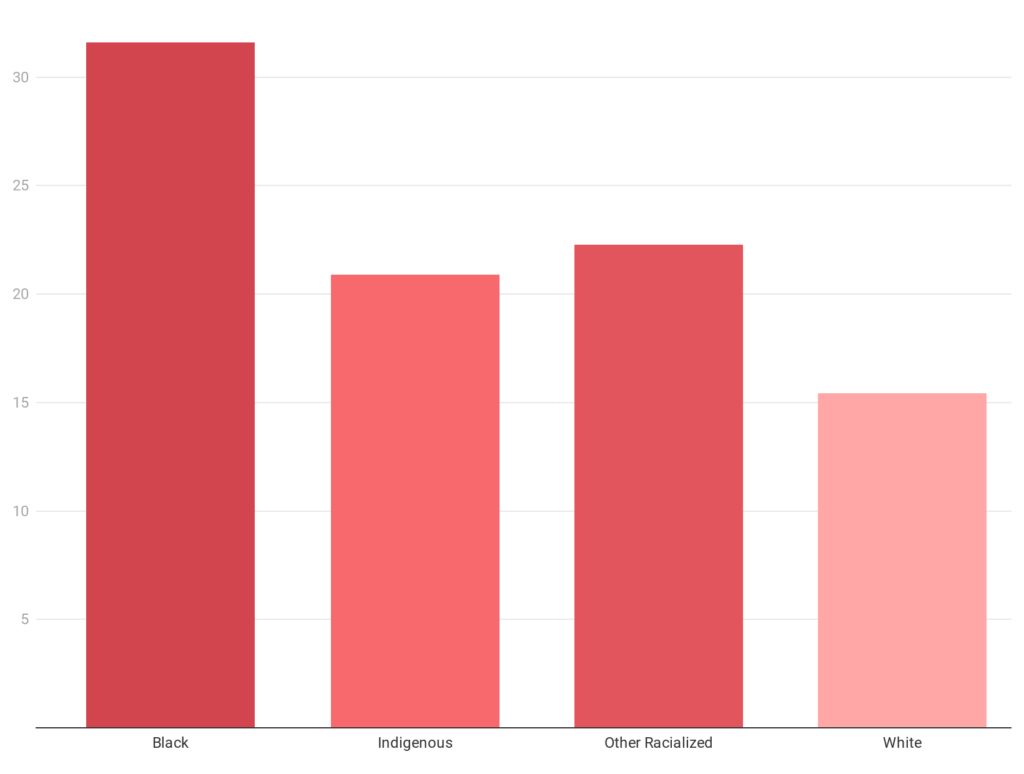The pandemic’s tightening grip and government efforts to strengthen public health measures are impacting employment in Canada: we lost 63,000 jobs between November and December 2020.
And with additional necessary public health measures this winter, we can expect even more job losses—especially among Black, Indigenous and other racialized workers who are concentrated in the sales and service occupations that have seen the largest drop in employment during this pandemic.
This analysis looks at the occupational distribution of jobs losses during the pandemic and differences in unemployment rates for Black, Indigenous and other racialized workers between August and December 2020. The upshot: the burden of unemployment, in particular youth unemployment, in Canada falls more heavily on these marginalized populations, in part because they are more likely to work in occupations that have been hard-hit by the economic impact of the pandemic.
Unemployment rates
Statistics Canada’s Labour Force Survey (LFS) began publishing race-based data in the summer of 2020. Chart 1 shows the average national unemployment rates for Black Canadians, Indigenous peoples, other racialized people and white workers aged 15-69.
Chart 1
It shows that, on average, 7.4% of white Canadians were unemployed during this time period—the lowest unemployment rate—while unemployment rates for Indigenous peoples, Black Canadians and other racialized people were significantly higher. At 13%, Black Canadians and Indigenous peoples had the highest unemployment rate: it averaged 75% higher than the rate for white Canadians. At 11.5%, the unemployment rate for other racialized people was not far behind.
December’s LFS showed that youth employment was 10.5% below pre-pandemic levels, compared to 1.8% for core-age workers. The unemployment rate for youth reveals an even greater disparity among these populations. Chart 2 shows that white youth had an average unemployment rate of 15.4%, while the unemployment rate for Black youth averaged 31.6%— twice as high. Indigenous youth and other racialized youth had unemployment rates that were 20.9% and 22.3% respectively.
Chart 2
There is evidence that recessions have long-term negative impacts on recent graduates, since entering the labour force during periods of higher unemployment can interrupt early career trajectories and the transition from school to work.
The negative labour market impact of racism on Black youth was evident even before the pandemic struck. The decrease in participation rates for youth in December could be an indicator of longer-term negative impacts. Prior to the pandemic, a higher proportion of Black youth was not in education, employment or training (NEET). The ongoing labour market disruption could exacerbate this. This could result in the longer-term economic costs of pandemic-related unemployment being disproportionately borne by Black youth.
Policy discussions on how to mitigate the impact of the pandemic on youth have begun; the situation demands an approach that integrates the unequal labour market impacts of the pandemic on racialized groups.
Employment by occupational group
Charts 3 and 4 compare the pre-pandemic share of employment by occupation and gender, with changes in employment since the start of the pandemic. Sales and service occupations saw the largest job losses between February and December 2020.
Chart 3
Chart 4
Almost 1 in 3 Black, other racialized, and Indigenous women work in these occupations—that’s a larger share than white women. While a larger share of white women’s employment (27%) is in these occupations compared to white men (18%) or Indigenous men (21%), white women have a similar share of employment in these occupations as other racialized men (25%) and equal to that of Black men (27%).
Job losses in the occupational groups of sales and service, trades, transport and equipment operators, and manufacturing and utilities disproportionately affected Black and Indigenous men. Pre-pandemic, those three categories accounted for 64% of total employment for Indigenous men, 59% of total employment for Black men, but only 52% of total employment for white men and 51% of employment for other racialized men.
Racialized men had a larger share of employment management occupations, which registered job losses between February and December 2020, compared to Black or Indigenous men. However, other racialized men had a smaller share of employment in trades, transport and equipment operation than other groups of men. In addition, at 14.6%, other racialized men had the highest share of employment in natural and applied science, which is the occupational group that had the largest increase in employment over this time period.
Racialized Canadians and Indigenous peoples have been disproportionately affected by the health and socio-economic impacts of the pandemic. We have written about the over-representation of racialized workers in front-line work and in care work and how they are at greater health risk.
The burden of unemployment is not equally shared either. In the short term, income supports for those facing losses of employment and income need to be maintained and enhanced to prevent further widening of the economic disadvantage experienced by Black, Indigenous and other racialized people.
The longer-term solutions are yet to be determined, because it is unclear what the post-pandemic occupational landscape will look like. But one thing is certain: policy makers will need to address unequal racialized impacts of the pandemic to ensure Canada’s economic recovery includes everyone. These policies will need to mitigate how the pandemic has worsened the pre-existing employment and income inequities that are baked into Canada’s labour market.
Data notes:
Since the pandemic began, Statistics Canada has made additional data available for racialized Canadians and Indigenous peoples. Previously, the LFS did not collect data on the labour market experience of racialized workers: the only data that was available was from the census, which is produced every five years and, therefore, made it difficult to track labour market impacts on racialized people in real time. While data on the off-reserve Indigenous labour market experience had been collected in the LFS prior to the pandemic, more detailed data is now being made available. Unfortunately, as a result of data availability and small sample sizes, we do not have an immediate pre-pandemic comparator to understand the impact of COVID-19 on Black and other racialized people and Indigenous peoples. LFS data that was used in this post to analyze labour market impacts on racialized Canadians was made available starting in August 2020. We used the average of the period from August to December 2020 to compare unemployment rates for Black, other racialized and white Canadians and Indigenous peoples. We used the 2016 census for pre-pandemic comparators for Black, other racialized and white Canadians (due to data limitations, the census data for white people includes Indigenous peoples). We used the 2019 annual averages for pre-pandemic comparators for Indigenous peoples.
Sheila Block is a senior economist with the CCPA-Ontario office.







